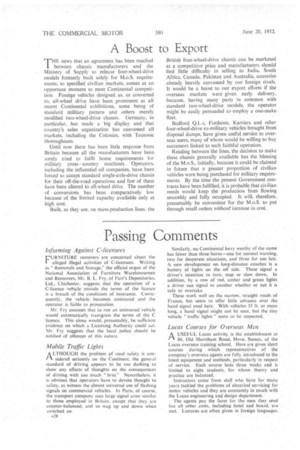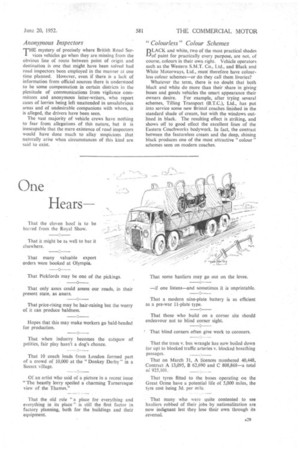Passing Comments
Page 30

Page 31

If you've noticed an error in this article please click here to report it so we can fix it.
Informing Against C-licensees
E'URNITURE removers are concerned about the I alleged illegal activities of C-licensees. Writing in "Removals and Storage," the official organ of the National Association of Furniture Warehousemen and Removers, Mr. B. L. Fry„ of Farr's Depositories, Ltd., Chichester, suggests that the operation of a C-licence vehicle outside the terms of the licence is a breach of the conditions of insurance. Consequently, the vehicle becomes uninsured and the operator is liable to Prosecution.
Mr. Fry assumes that to run an uninsured vehicle would automatically transgress the terms of the C licence. This alone would, presumably, be sufficient evidence on which a Licensing Authority could act. Mr. Fry suggests that the local police should be
notified of offences of this nature. •
Mobile Traffic Lights
A LTHOUGH the problem of road safety is con1-1 sidered seriously on the Continent, the general standard of driving appears to be too dashing to show any effects of thoughts on the consequences of driving with too much "brio." Nevertheless, it is obvious that operators have to devote thought to safety, as witness the almOst universal use of flashing signals on commercial vehicles. In Paris, of course, the transport company uses large signal arms similar to those employed in Britain, except that they are counter-balanced, and so wag up and down when switched on.
A/8
Similarly, no Continental lorry worthy of the name has fewer than three horns—one for normal warning, two for desperate situations, and three for too late. A new development on long-distance coaches is a battery of lights on the off side. These signal a driver's intention to turn, stop or slow down. In addition, by a row of red, amber and green lights a driver can signal to another whether or not it is safe to overtake.
These work well on the narrow, straight roads of France, but seem to offer little advance over the hand signal used here. With vehicles 35 ft. or more long, a hand signal might not be seen, but the tiny vehicle "traffic lights" seem to be respected.
Lucas Courses for Overseas Men
A USEFUL Lucas activity is the establishment at ". 86, Old Shoreham Road, Hove, Sussex, of the Lucas overseas training school. Here are given short courses during which representatives of the company's overseas agents are fully introduced to the latest equipment and methods, particularly in respect of service. Each course lasts three .weeks and is limited to eight students, for whom theory and practice are balanced.
Instructors come from staff who haVe for many years tackled the problems of electrical servicing for motor vehicles and they are constantly in touch with the Lucas engineering and design department.
The agents pay the fares for the men they send but all other costs, including hotel, and board, are met. Lectures are often given in foreign languages.
Anonymous Inspectors
T"mystery of precisely where British Road Services vehicles go when they are missing from the obvious line of route between point of origin and destination is one that might have been solved had road inspectors been employed in the manner at one time planned. However, even if there is a lack of information from official sources there is understood to be some compensation in certain districts in the plenitude of communications from vigilance committees and anonymous letter-writers, who report cases of lorries being left unattended in unsalubrious areas and of undesirable companions with whom, it is alleged, the drivers have been seen.
The vast majority of vehicle crews have nothing to fear from allegations of this nature, but it is inescapable that the mere existence of road inspectors would have done much to allay suspicions ,that naturally arise when circumstances of this kind are said to exist. •
"Colourless" Colour Schemes
n LACK and white, two of the most practical shades paint for practically every purpose, are not, of course, colours in their own right. Vehicle operators such as the Western S.M.T. Co., Ltd., and Black and White Motorways, Ltd., must therefore have colourless colour schemes—or do they call them liveries? Whatever the term, there is no doubt that both black and white do more than their share in giving' buses and goods vehicles the smart appearance their owners desire. For example, after trying several schemes, Tilling Transport (B.T.C.), Ltd., has put into service some new Bristol coaches finished in the standard shade of cream, but with the windows outlined in black. The resulting effect is striking, and shows off to good effect the excellent lines of the Eastern Coachworks bodywork. in fact, the contrast between the featureless cream and the deep, shining black produces one of the most attractive " colour " schemes seen on modern coaches.




















































































